

Titan Submarine: Exploring the Depths of Kraken Mare. Steven Oleson NASA Glenn Research Center Description Phase II of the Titan Submarine: Exploring the Kraken Mare effort will focus on advancing the Technology Readiness Level (TRL) of the concept by (1) retiring risks found in the Phase I design, (2) gathering new Kraken Sea observations by Cassini, and (3) further defining science goals and instruments to fulfill them; each of these tasks will feed into two COMPASS design sessions.
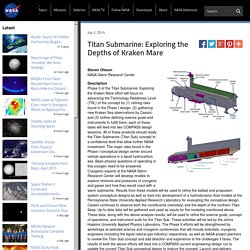
All of these products should ready the Titan Submarine (Titan Sub) concept to a confidence level that allow further NASA investment. The major risks found in the Phase I conceptual design center around vehicle operations in a liquid hydrocarbon sea. Basic physics questions of operating in this cryogen need to be answered. Cryogenic experts at the NASA Glenn Research Center will develop models to explore mixtures and pressures of cryogens and gases and how they would react with a warm submarine. Enceladus's Ice Volcanoes Are Feeding Saturn's Rings. The Mystery Of Titan's Wrong-Way Dunes May Have Finally Been Solved. Life 'not as we know it' possible on Saturn's moon Titan. A new type of methane-based, oxygen-free life form that can metabolize and reproduce similar to life on Earth has been modeled by a team of Cornell University researchers.
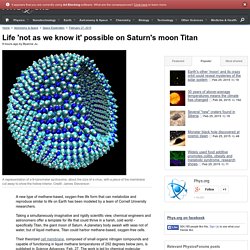
Taking a simultaneously imaginative and rigidly scientific view, chemical engineers and astronomers offer a template for life that could thrive in a harsh, cold world - specifically Titan, the giant moon of Saturn. How NASA Might Use A Robotic Sub To Explore Titan's Methane Seas. The Origins Of The Windswept Dunes On Titan. Titan. Titan’s Atmosphere May be Older than Saturn, a New Study Suggests.
Want to stay on top of all the space news?

Follow @universetoday on Twitter Titan’s atmosphere makes Saturn’s largest moon look like a fuzzy orange ball. Image Credit: NASA / JPL-Caltech / Space Science Institute It’s well accepted that moons form after planets. In fact, only a few months ago, astronomers spotted a new moon forming deep within Saturn’s rings, 4.5 billion years after the planet initially formed. But new research suggests Saturn’s icy moon Titan — famous for its rivers and lakes of liquid methane — may have formed before its parent planet, contradicting the theory that Titan formed within the warm disk surrounding an infant Saturn.
A combined NASA and ESA-funded study has found firm evidence that the nitrogen in Titan’s atmosphere originated in conditions similar to the cold birthplace of the most ancient comets from the Oort cloud — a spherical shell of icy particles that enshrouds the Solar System. The hint comes in the form of a ratio. About Shannon Hall. Mysterious 'Magic Island' appears on Saturn's moon Titan. Now you don't see it.
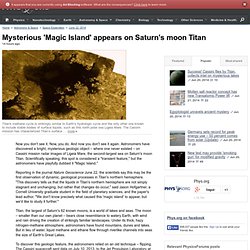
Now, you do. And now you don't see it again. Astronomers have discovered a bright, mysterious geologic object – where one never existed – on Cassini mission radar images of Ligeia Mare, the second-largest sea on Saturn's moon Titan. Scientifically speaking, this spot is considered a "transient feature," but the astronomers have playfully dubbed it "Magic Island. " Reporting in the journal Nature Geoscience June 22, the scientists say this may be the first observation of dynamic, geological processes in Titan's northern hemisphere. NASA wants to send a quadcopter to Saturn’s giant moon Titan.
Saturn’s largest moon Titan fascinates the scientists at NASA due to its dense atmosphere and the presence of stable bodies of surface liquid alongside ice and rock.

The nitrogen rich atmosphere experiences wind and rain, meaning the mix has produced a moon with similar features to Earth’s own surface, complete with rivers, lakes and seas (of liquid methane or ethane), mountains, and dunes. Such an interesting place deserves to be explored, but visiting Titan for an extended period of time hasn’t been feasible due to a lack of supporting technology.
NASA’s ideal vehicle for exploration there would be a helicopter, able to move quickly from place-to-place taking photos and collecting samples. But such a craft would be too expensive to develop and deploy, we haven’t had the tech to make it work autonomously, and even then you wouldn’t be able to support it. First Extraterrestrial Waves Ever Spotted On Titan.
Saturn’s largest moon, Titan, looks a lot like Earth, except in deepfreeze.

It’s got a nitrogen atmosphere, along with lakes and seas, channels sculpted by rivers, and even mudflats and rain clouds. The moon is so much like our planet that it’s a frequent setting for sci-fi: the (spoiler alert) promised land for Tom Cruise’s character in Oblivion, as well as the setting for Kurt Vonnegut’s second novel. But while Titan appears so earthlike in so many ways, it's still a very alien place. The moon’s lakes and seas are not made of H2O -- at minus 290 degrees Fahrenheit, Titan’s surface is way too cold for liquid water. Researchers believe their water is actually a mixture of hard-to-freeze hydrocarbons like methane. NASA's Cassini spacecraft may have found the answer. You won't believe how amazing this footage of Saturn's moon Titan is. Take a trip over Titan's massive methane-filled lakes. Cassini Find: "Salt Flats" Surround Titan's Northern Lakes. This is awesome!
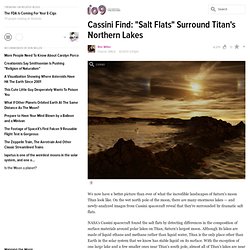
I have to admit, I wasn't a fan of io9 at first, having come from a site with a wholly different structure (my eyes and brain have a difficult time adjusting to new layouts if there's too drastic a difference, one of many reasons you don't find me on computers often) but as a writer*, this has become one of my favorite sites.
Not only are the articles well researched, but they're often presented by people in those fields, and they're incredibly well written as well. The information that I get off this site on a daily basis is incredibly informative. And as I'm in the middle of researching a novel and am currently world building a science fiction home for humanity approximately 120 years from now, it's information like this (geography and other types of data) which will help color much of what I write. I find myself reading one of these articles then looking at the clock and realizing I've spent 6 or so hours finding out as much as I can about it. Love this site.
Facebook. Huygens: Titan Descent Movie (2005.01.14) Eight New Names for Titan Surface Features - USGS Astrogeology Hot Topics. Mount Doom, Einstein Crater, and Arrakis Plains: Geekiest Place Names in the Solar System. Ancient civilizations gave us the names of planets in our solar system.

But as modern scientists have zoomed in on these bodies and their moons, they have needed to find names for ever more features on their surfaces.Following the tradition of naming planets after Greek and Roman deities, most place names in the solar system are derived from mythology. Thus, mountains, craters, valleys, and other geologic features on Venus come from names for sky goddesses, water goddesses, desert goddesses, war goddesses, or goddesses of love, fate, fortune, and fertility.But sometimes it seems that astronomers get a little tired of always asking their mythology friends for new pantheons to mine for names.
Image: LROC/NASAArtists and AuthorsPlenty of cultured nerds will find all they need on Mercury, whose craters are named after famous artists, painters, musicians, and authors. Charting Titans River System. For many years, Titan’s thick, methane- and nitrogen-rich atmosphere kept astronomers from seeing what lies beneath. Saturn’s largest moon appeared through telescopes as a hazy orange orb, in contrast to other heavily cratered moons in the solar system. Facebook. Saturn’s moon Titan shows surprising seasonal changes. Detailed observations of Saturn’s moon Titan have now spanned 30 years, covering an entire solar orbit for this distant world.
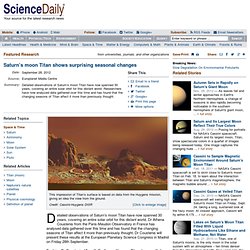
Dr Athena Coustenis from the Paris-Meudon Observatory in France has analysed data gathered over this time and has found that the changing seasons of Titan affect it more than previously thought. Dr Coustenis will present these results at the European Planetary Science Congress in Madrid on Friday 28th September. Explains Dr Coustenis, “As with Earth, conditions on Titan change with its seasons. We can see differences in atmospheric temperatures, chemical composition and circulation patterns, especially at the poles. For example, hydrocarbon lakes form around the north polar region during winter due to colder temperatures and condensation.
The main cause of these cycles is solar radiation. The Universe's Photos. High Altitude Haze and Vortex Seen at Titans South Pole. Images from NASA's Cassini spacecraft show a concentration of high-altitude haze and a vortex materializing at the south pole of Saturn's moon Titan, signs that the seasons are turning on Saturn's largest moon. "The structure inside the vortex is reminiscent of the open cellular convection that is often seen over Earth's oceans," said Tony Del Genio, a Cassini team member at NASA's Goddard Institute for Space Studies, N.Y. "But unlike on Earth, where such layers are just above the surface, this one is at very high altitude, maybe a response of Titan's stratosphere to seasonal cooling as southern winter approaches. But so soon in the game, we're not sure. " Cassini first saw a "hood" of high-altitude haze and a vortex, which is a mass of swirling gas around the pole in the moon's atmosphere, at Titan's north pole when the spacecraft first arrived in the Saturn system in 2004.
At the time, it was northern winter. The new images are available online at: